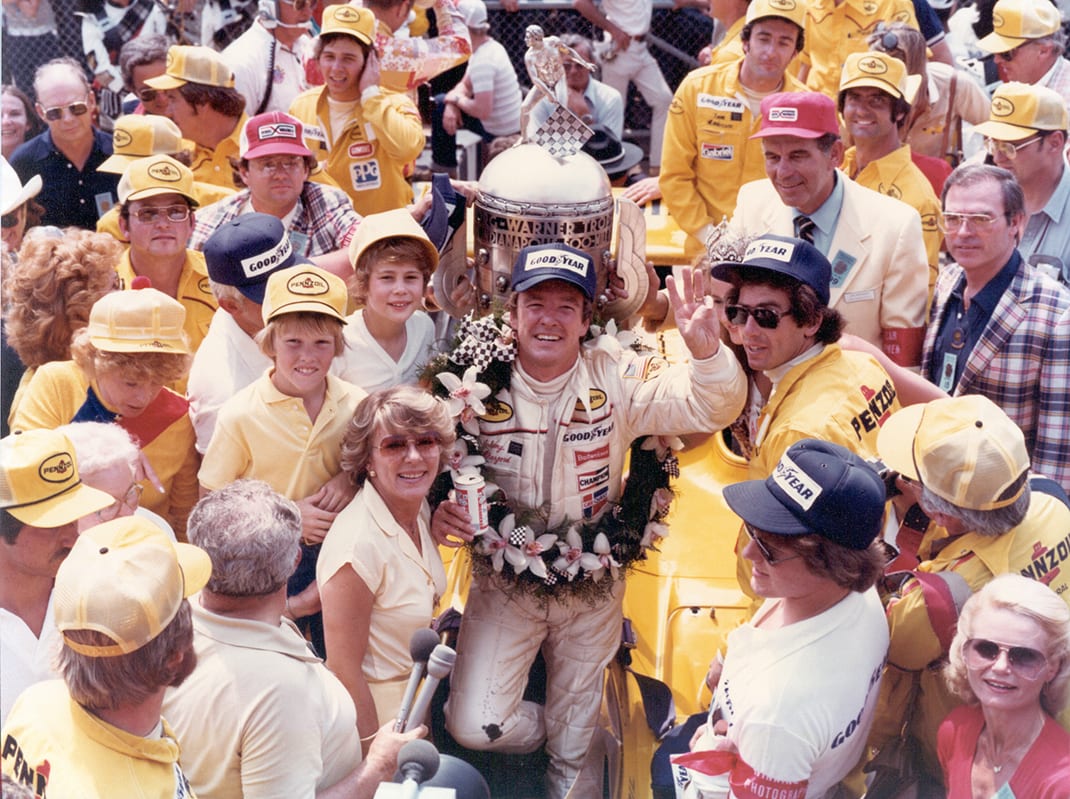The car leapt to life. The more they tweaked it, the faster it went. Before the session ended Rutherford lapped two seconds under the track record. The amount of grip generated by the ground effects stunned Rutherford.
“That was the first time I ever had a race car that made enough lateral Gs to make me grunt,” Rutherford shared with journalist Gordon Kirby. “It would absolutely make me grunt as it turned into the corner.”
Rutherford knew he had a world-beater and proved it at the opening race of the season.
The 200-miler scheduled for April 13 at Ontario Motor Speedway in California was jointly sanctioned by USAC and CART, under the auspices of the Championship Racing League.
The CRL was a peacemaking attempt devised by both sides during that politically tumultuous time. A tense agreement at best, it unraveled before season’s end.
The turmoil didn’t impact the racing, however. Rutherford qualified on the pole, led 185 of the 200 miles and lapped the 25-car field.
Ontario was a preview of Indianapolis and from the opening of Indy practice, Rutherford established himself as the favorite. He set quick time on every practice day except one, when a promising rookie, Tim Richmond, snuck in a quick lap.
The consensus was the pole was his to lose. Rutherford didn’t disappoint. When the day ended, he occupied the starting spot that brought nearly as much attention and fame as winning the race. Second-place starter Mario Andretti was a full mile-per-hour slower.

On race morning during those tension-filled moments that precede the start of an Indianapolis 500, Rutherford recalls he was talking to Hall and Robey when he felt something in his hair. He flicked his hand through it, and a ladybug fell out. He perceived that a good luck omen and quipped to Hall and Robey, “We got this race won.”
At the green flag, Bobby Unser jumped from third starting spot and pulled alongside Rutherford entering turn one. They ran wheel to wheel until Rutherford blew by across the short chute. That pretty much was the tale of the race.
Rutherford relinquished the lead during his pit stops, but few other times. When he did struggle with the car’s handling, he remained patient. On stops, slight adjustments brought the “Yellow Submarine,” so nicknamed because of sponsor Pennzoil’s distinctive color scheme, back to life.
Thirty laps from the end, Rutherford was third after making his final pit stop, trailing Tom Sneva, who had started last, and Rick Mears. Rutherford passed them with ease, throwing them a jaunty wave in the process.
“When things are going right, I always acknowledge everybody I pass. It’s not a defiant gesture or anything. I’m just saying thanks for not getting in my way. Or, see you in a lap,” laughed Rutherford.
Rutherford led 118 laps and finished 30 seconds ahead of Sneva. With his third 500 victory, he joined an elite group of three-time 500 winners — Louis Meyer, Wilbur Shaw, Mauri Rose and Al Unser.
While many pre-race predictions practically conceded him the race, Rutherford was acutely aware of how wicked a mistress Indianapolis could be.
“The speedway is a different lady,” mused Rutherford. “She can throw so many curves at you, it’s unbelievable. It’s an incredible place, so to win even one 500 is special. To win three is beyond words.”
One of the most memorable happenings of that 500, certainly one of the most photographed, occurred after the checkered flag. Cruising toward pit road after his cool-down lap, Rutherford spotted Tim Richmond walking at the head of the main stretch. Rutherford stopped, Richmond hopped on and the future NASCAR star hitched a ride to a tremendous ovation from the fans.
After Indianapolis, Rutherford won four more Indy car races and with three second-place finishes, easily out-pointed Bobby Unser for the national championship. Coinciding with that, Rutherford also took the abbreviated USAC Indy car championship.
After five races under the CRL banner, USAC President John Cooper pulled the sanctioning body out of the agreement. He felt USAC had extended too many concessions to CART. Rutherford won three of the USAC points-paying events to take their crown.
Ironically, after waiting 19 years to win an Indy car championship, Rutherford wasn’t around to accept the CART trophy. He was in the hospital.
During the season-ending race at Phoenix, Rutherford tried to lap Dennis Firestone. Suddenly, Firestone’s car slid up the track, pushing Rutherford into the wall. The car rolled up on its rear wheel, flipped over and slid several hundred feet upside down.
With the roll bar collapsed to half its height, only Rutherford’s Simpson helmet protected him. It held despite a huge dent on one side and a three-inch split up the back. It was a frightening accident, but the helmet prevented it from being fatal.
Rutherford spent the night in the hospital, while Betty Rutherford accepted the championship accolades.
“The 1980 season was an incredible one for me personally,” recalled Rutherford. “To be able to carry the number one on my car the next year was sweet. Plus, to play a role in developing a car with a concept that is still used in racing today is extremely satisfying.” n
